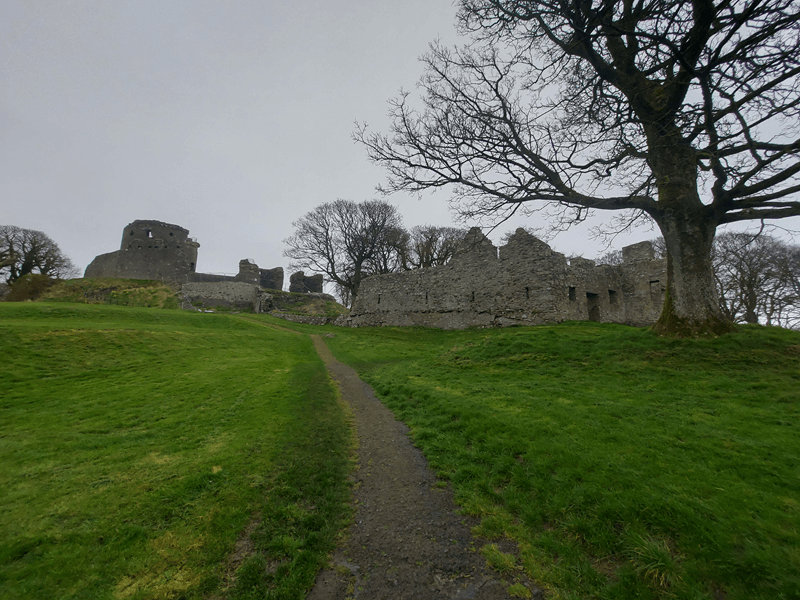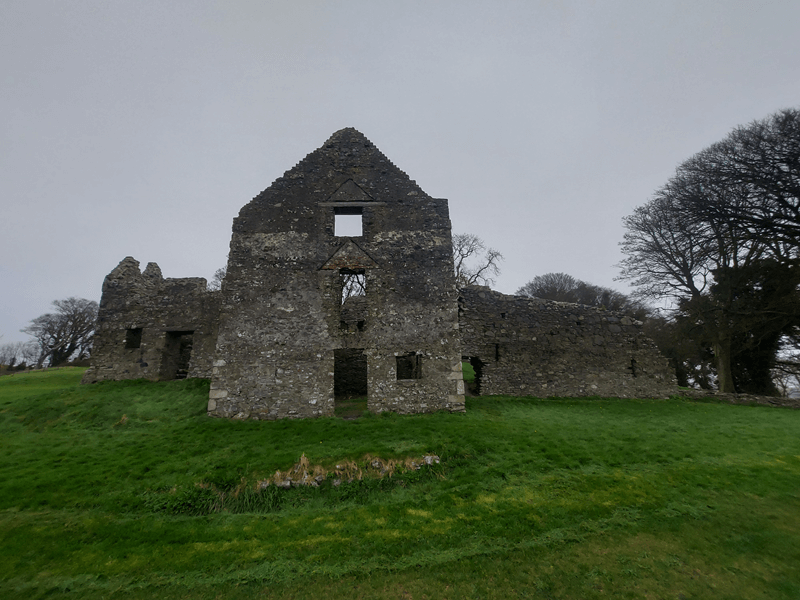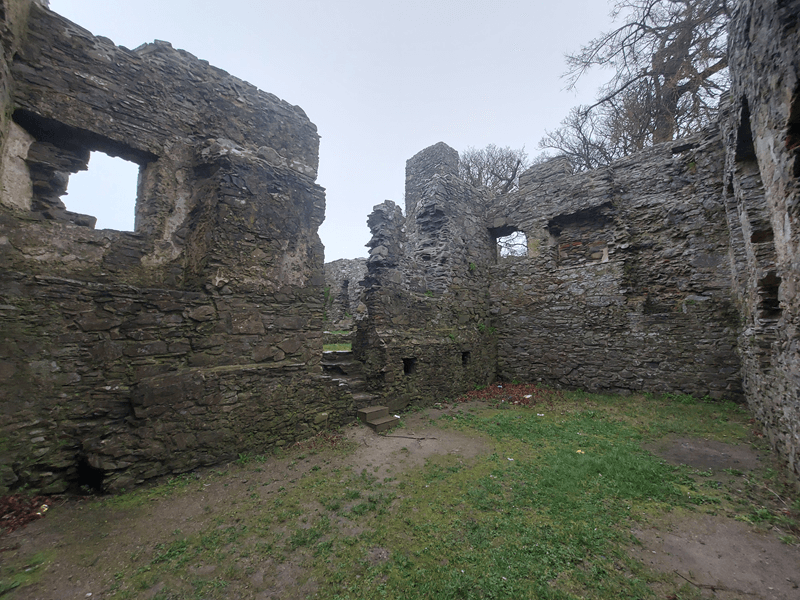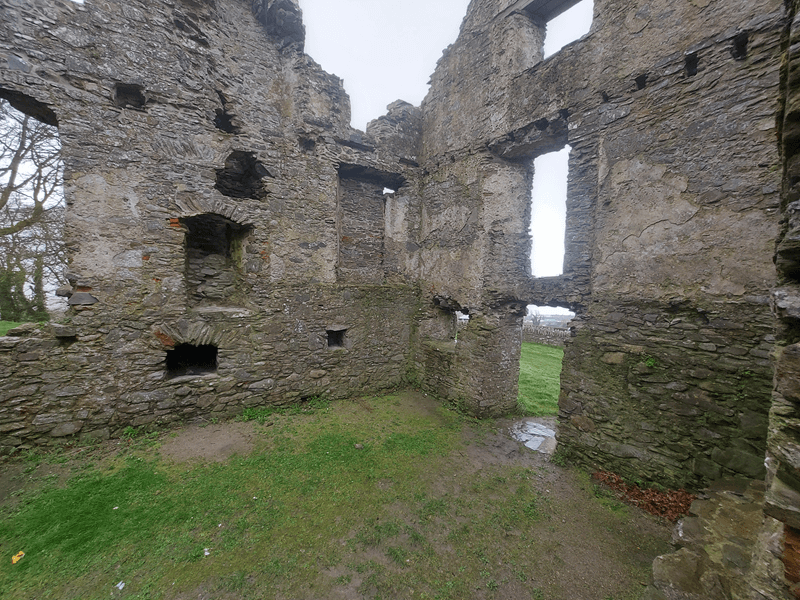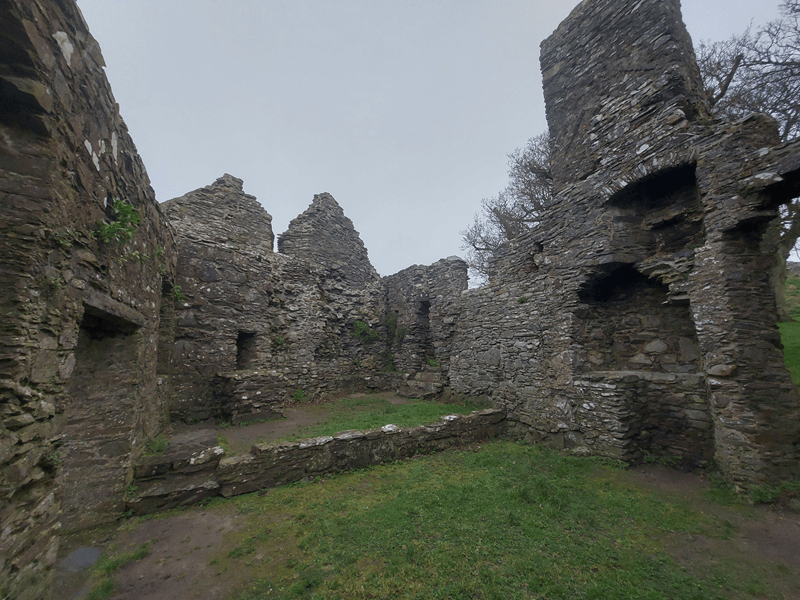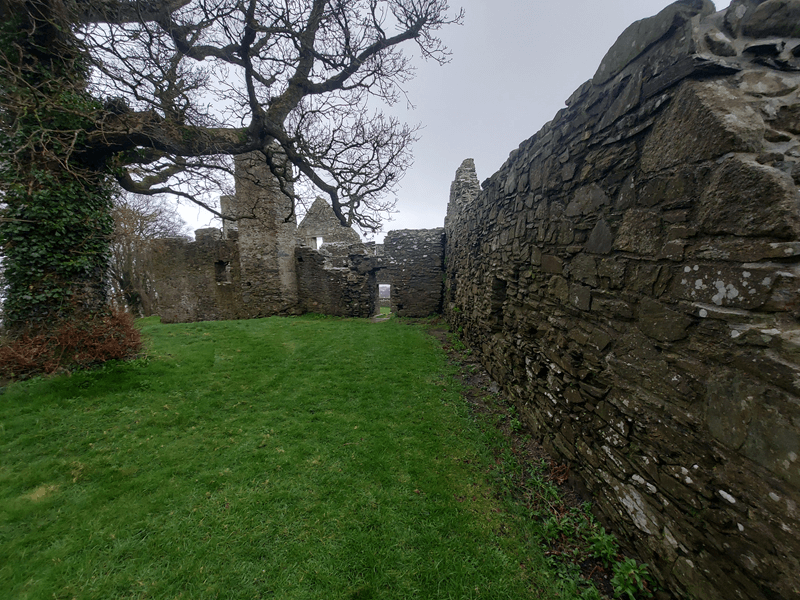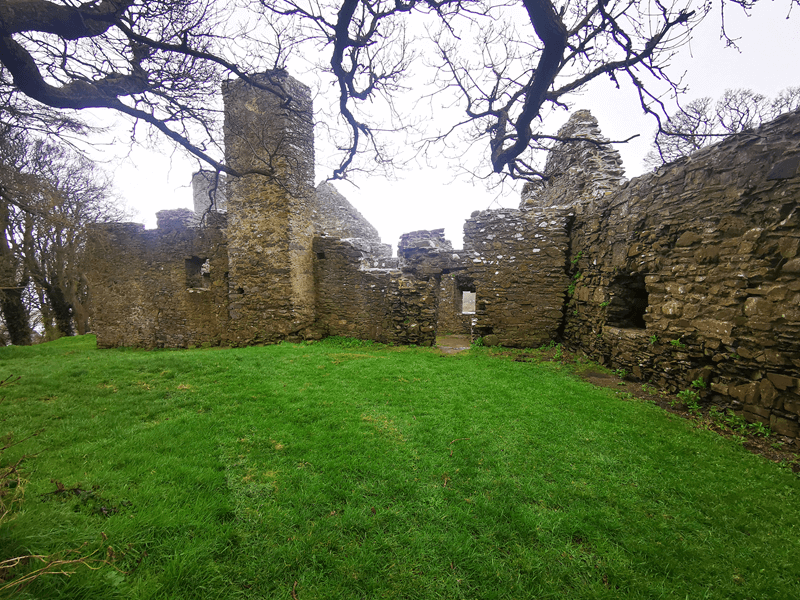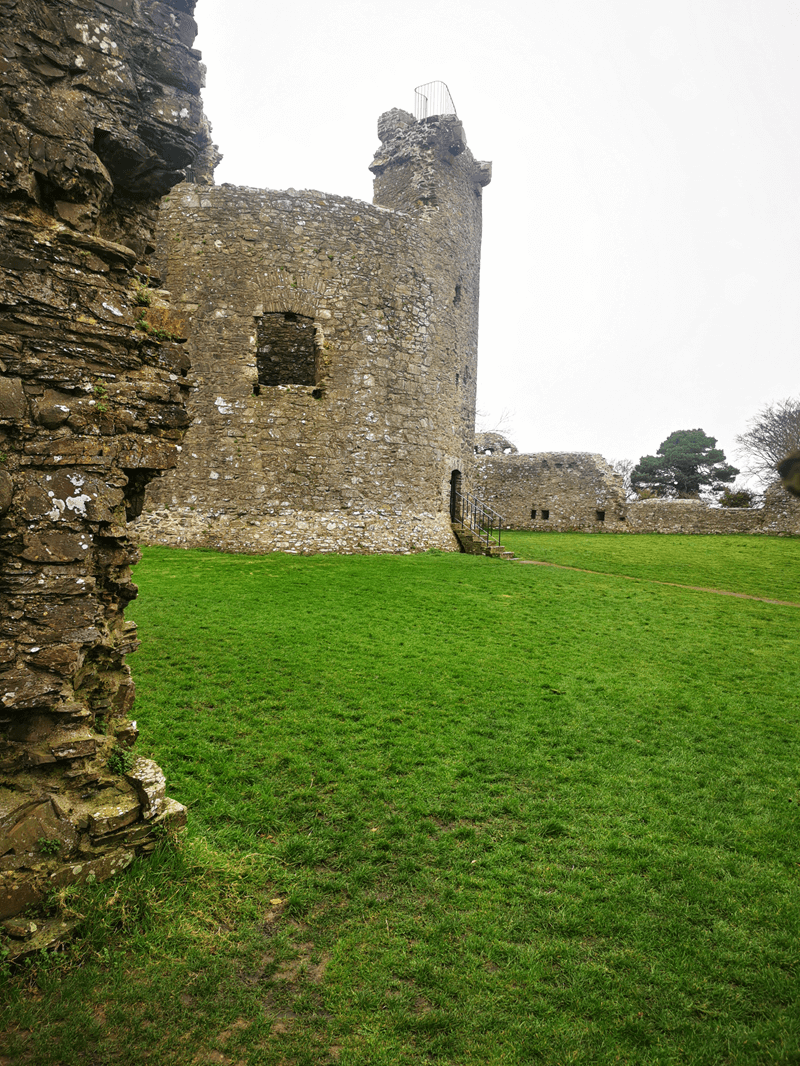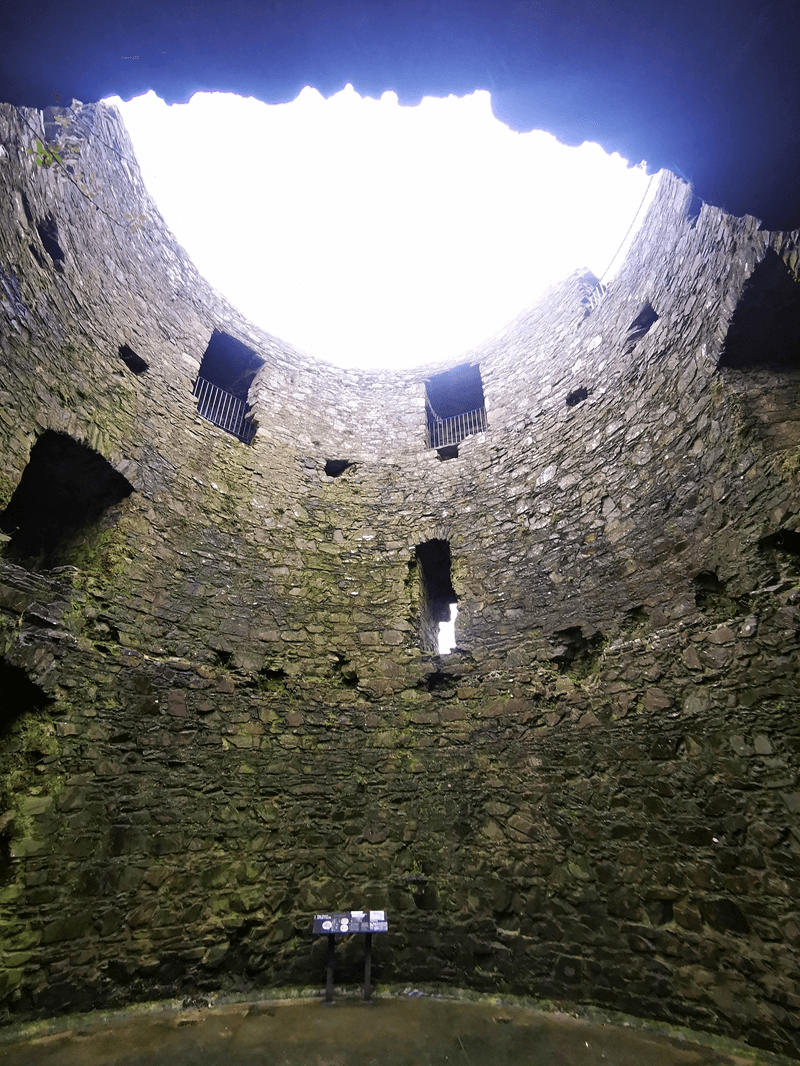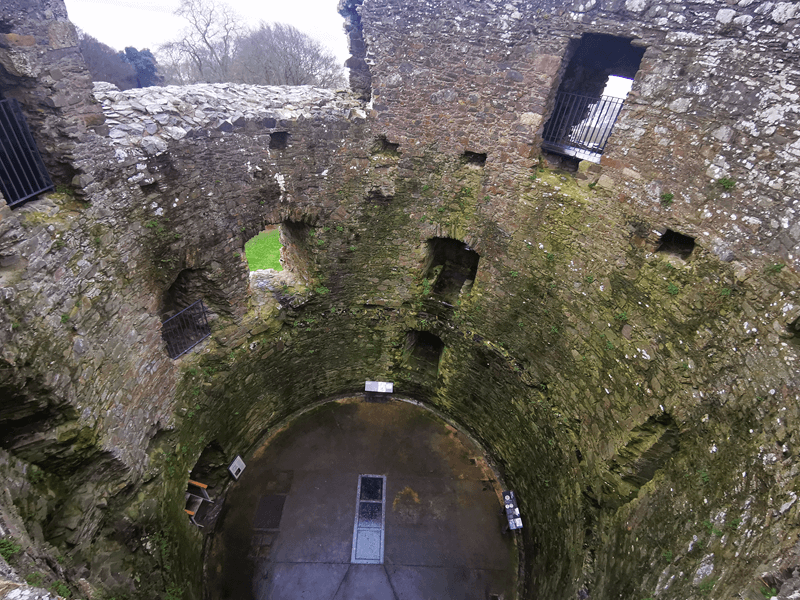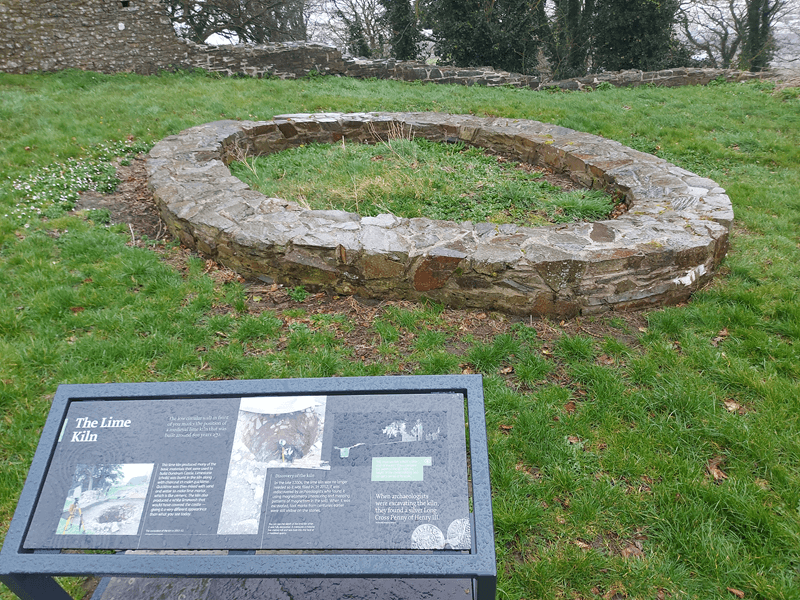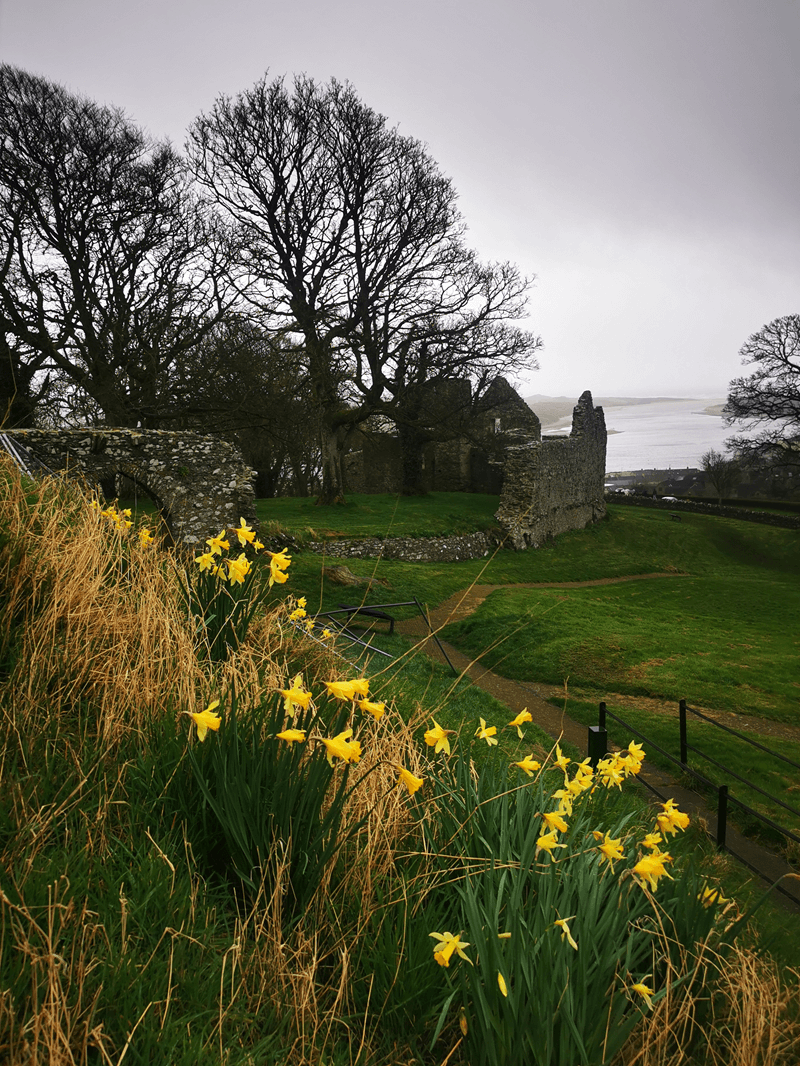History
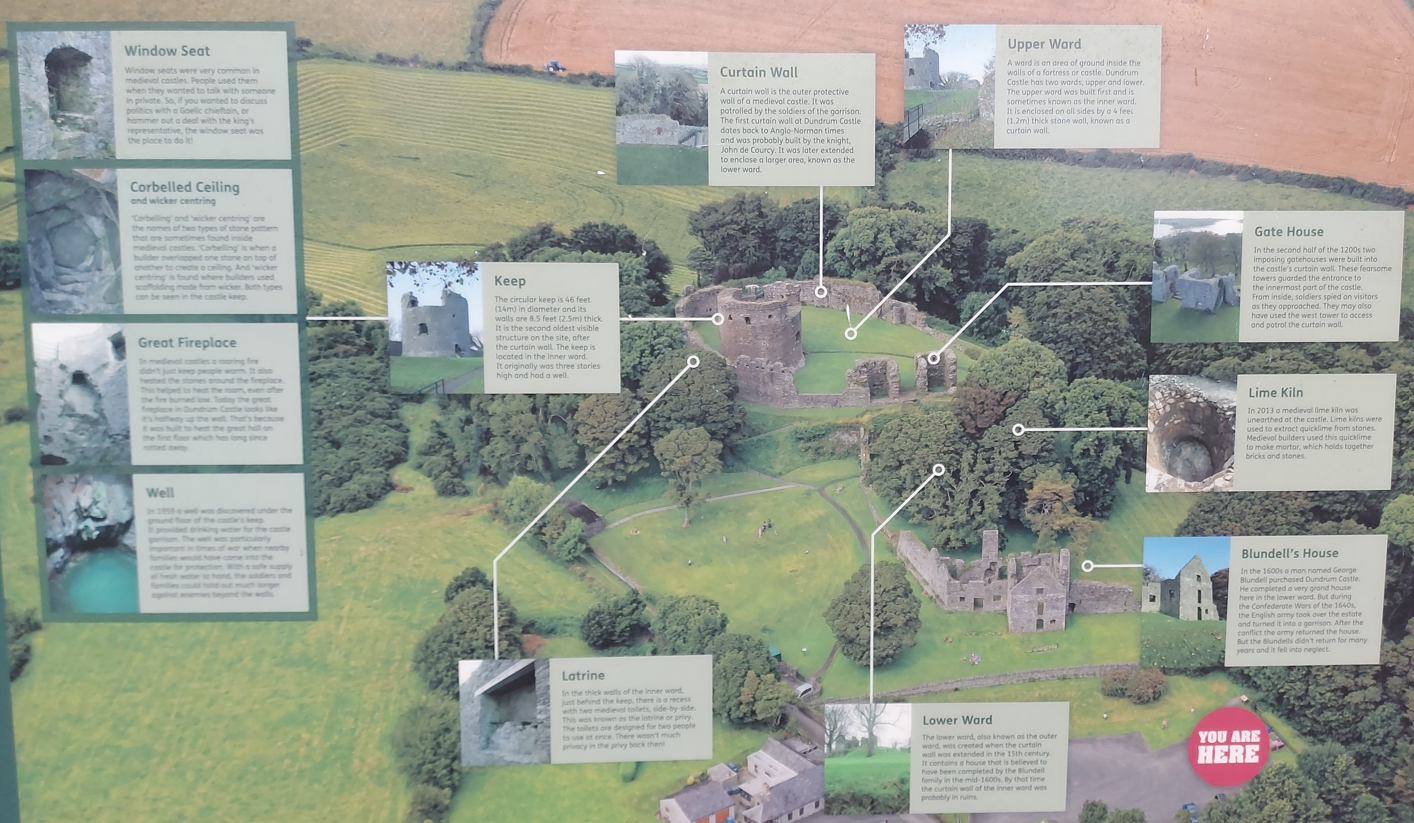
Most of the information reported on this page are taken from the several and well detailed panels placed on the site by the Department for Communities [1] and the Environment and Heritage Service [2].
First of all, the name Dundrum derives from Dún Droma, meaning fort (“dún”) of the ridge (“droma”), as reported in the Book of Leinster (circa 1160).
Dundrum castle stands on a 61m hill overlooking Dundrum bay and the Mourne Mountains, dominating the landscape around it and hence being selected for controlling the area.
An interesting panel shows all the buildings composing the site (refer to the picture at the top of this section):
- The lower ward (or outer ward), created in the 15th century and containing the Blundell’s house.
- The Blundell's house, whose construction was completed by George Blundell in the 17th century, after he purchased Dundrum castle. Later, during the Confederate Wars of the 1640s, the English army took over the estate and turned it into a garrison, before returning it to the the Blundell family once the conflict was over. However, the Blundells decided to not come back and the house fell into neglect.
- The lime kiln, unearthed in 2013, was used to extract quicklime, used to make mortar, to hold together bricks and stones.
- The curtain wall is the outer protective wall of the castle, probably initially built by John de Courcy, and later extended to make space for the lower ward.
- The gate houses were built into the castle’s walls in the second half of the 1200s, to guard the entrance to the upper ward and the keep.
- Located in the upper (inner) ward, the circular keep, with its 14m long diameter and 2.5m thick walls, was originally three stories high. The keep also included a cistern providing water, made by digging a 7m deep well in the ground, helping the owners of the keep and the soldier to hold out against long sieges.
- The upper ward (or inner ward) surrounds the keep and is enclosed on all sides by the curtain wall.
- Latrine: in the thick walls of the inner ward, just behind the keep, there is a recess with two medieval toilets.
Due to his ambition, de Courcy was always seen with suspect by the Kings of England who ruled in this period. As reported in [3], in 1177, de Courcy defeated the last King of Ulaid, Ruaidhrí Mac Duinnshléibhe, with the authorization of King Henry II. In 1205, as John de Courcy was gaining more prestige and power in the North of Ireland, King John of England decided to dismiss him and to replace him with Hugh de Lacy, de Courcy’s major rival, who was appointed the first Earl of Ulster [3] and to whom the castle was granted. These events were followed by a battle between Hugh de Lacy, supported by his brother Walter, and John de Courcy, the latter being defeated [3] and finally expelled from Ulster.
Soon later, when de Lacy gave shelter to William de Braose, enemy of the crown, the King came to Ulster and put the castle under siege. Before surrendering, de Lacy’s men started fires and destroyed the castle from the inside. King John had then to repair the castle and took possession of it. In 1210, de Lacy fled to France but he managed to reconquer the favour of King Henry III and hence he was again entrusted with the castle. In 1227, de Lacy returned to Ulster, before dying in 1234, with Dundrum back under the crown.
It was during the ownership of Earl de Lacy that the circular stone keep was built and the castle defences were reinforced.
In 1315, Edward the Bruce, brother of Robert the Bruce, King of Scots, invaded Ireland and waged war against the Anglo-Normans. At the same time, the great famine of 1315-1317 spread in Ulster. It was only by the mid-1300s that the situation around the castle settled and a period of peace started.
Since 1346, the lands around Dundrum castle passed into the hands of the Mac Aonghasa (Magennis) clan, hence sometimes the castle is called “Magennis castle” [4].
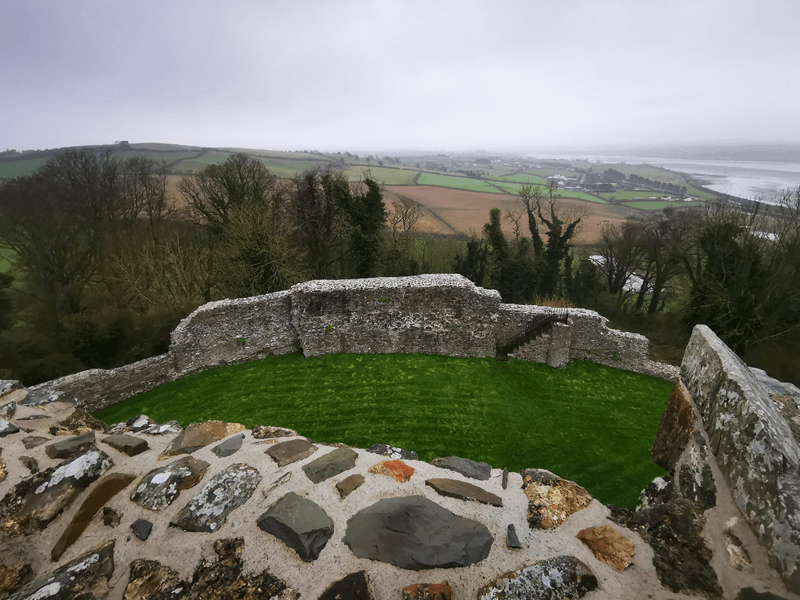 Let’s now jump to the 16th century. Although the Magennis clan continued to control these lands, the Earl of Kildare briefly captured the castle in 1517 [4] and later, by 1537, the crown gained the possession of the castle, since Leonard Grey, Lord Deputy of Ireland, captured it. During this period, the area was dominated on one side by Hugh Magennis who leaded a peaceful life, loyal to the King. On the other side, the powerful Gaelic chieftain, Hugh O’Neill, dominated the scene, willing to expand his control over all Ulster. After Hugh Magennis died, Hugh O’Neill got close to his son, Arthur Magennis and convinced him to turn against the King, to conquer more power. Finally, in 1593 the nine years’ war broke out. O’Neill, Magennis and other Gaelic chieftains around the country scored several victories against the crown. At Dundrum, where O’Neill placed his men, Queen Elizabeth’s forces succeeded and, in 1601, Phelim Magennis was force to surrender the castle to Lord Mountjoy, at that time, nominated Lord Deputy of Ireland by the crown. Finally, the crown forces won the nine years’ war and a few years later, in 1607, the surviving Gaelic earls flee into exile, in what is known as the “Flight of the Earls”, starting the plantation of Ulster.
Let’s now jump to the 16th century. Although the Magennis clan continued to control these lands, the Earl of Kildare briefly captured the castle in 1517 [4] and later, by 1537, the crown gained the possession of the castle, since Leonard Grey, Lord Deputy of Ireland, captured it. During this period, the area was dominated on one side by Hugh Magennis who leaded a peaceful life, loyal to the King. On the other side, the powerful Gaelic chieftain, Hugh O’Neill, dominated the scene, willing to expand his control over all Ulster. After Hugh Magennis died, Hugh O’Neill got close to his son, Arthur Magennis and convinced him to turn against the King, to conquer more power. Finally, in 1593 the nine years’ war broke out. O’Neill, Magennis and other Gaelic chieftains around the country scored several victories against the crown. At Dundrum, where O’Neill placed his men, Queen Elizabeth’s forces succeeded and, in 1601, Phelim Magennis was force to surrender the castle to Lord Mountjoy, at that time, nominated Lord Deputy of Ireland by the crown. Finally, the crown forces won the nine years’ war and a few years later, in 1607, the surviving Gaelic earls flee into exile, in what is known as the “Flight of the Earls”, starting the plantation of Ulster.At the beginning of the 17th century, with the country recovering after the war, Dundrum castle is owned by Thomas Cromwell (nothing to do with Oliver), who decides to build a nobleman’s house in the lower ward. As the plan turned to be too costly and Cromwell can not afford the expenses, in 1636 Sir Francis Blundell became the owner of Dundrum castle and completed the construction of the house, with its large windows and landscaped garden, proving that defences were no longer considered a priority by the new owners. However, in the early 1640s a new war breaks out and the Royalist army occupies the Dundrum estate. Before leaving the castle in 1652, the Parliamentarian forces damaged it before abandoning it. The Blundell family chose not to come back.
The house and the rest of the property started falling into neglect. At the beginning of the 18th century, the estate passed to Montague, Viscount Blundell. At his death, the property was divided between his three daughters. In 1786, Mary Sandys, who had inherited the estate, became Marchioness of Downshire after marrying Arthur Hill and begun the creation of a landscape garden in the foothills of the castle. At the beginning of the 19th century, the Hills started developing Dundrum village.
In 1954, the site passed into State Care and can be freely visited.
There are a couple of legends that we found reading the panels when visiting the castle and the curious visitor might like to know about, if brave enough…
The first one dates back to the 16th century, when English soldiers were marching through Ulster and, leaded by Lord Deputy Leonard Grey, were used to committ savage and cruel massacres of local people. In county Down, Lord Deputy Grey ordered the sack of a monastery (you might have already encountered this character when visiting [Carrigogunnell castle], in County Limerick, where he was responsible for an atrocious massacre of non-combatants Irish people). It is narrated that a Saxon captain stole the relic of Saint Catherine. Suddenly, the stones of Dún Droma cried out for vengeance. Indeed, a few days later, when the soldier reached Dundrum, a hole opened in the earth as the relic was claimed. The captain was swallowed and never seen again.
This is also a story from the Ulster Cycle of Irish mythology, that dates back to the 8th century and is found in several manuscripts, including the Lebor na hUidre (circa 1106) [5]. This second legend is enviromented at Dundrum and has the Irish warrior hero Cúchulainn as protagonist. It is known as the Bricriu's Feast (in old Irish, "Fled Bricrenn"). The troublemaker Bricriu organized a great feast at his new bruiden (hostel, banquet hall) at Dún Rudraige (Dundrum, County Down), in honour of King Conchobar. Invitations were sent to all Irish chieftain across the country and everyone accepted. As the guests sat, Bricriu rose and said that there was a “champion's portion” at the meal for the one who deserved it. With that, all guests started arguing, till Cúchulainn, Conall Cernach (the Victorious), and Lóegaire Búadach (the Triumphant) rose. Cú Roí, King of Munster, had to decide who deserved the “champion’s portion”. The three heroes performed several challenges and Cúchulainn was always proclaimed champion, but the other two refused to accept their defeat. Hence, Cú Roí introduced the last opponent, a great giant. The challenge for the knights consisted in beheading the giant, on the condition that they allowed him to cut off their heads in return. The knights accepted the challenge but surprisingly when they cut the giant’s head a new head grew again. At that point, Lóegaire and Conall ran away. Only Cúchulainn faced his destiny: he bowed his head, to respect the agreement. It was then that the giant transformed in King Cú Roí, who had contrived a monster’s spell to measure the courage and honour of the three knights. Cúchulainn had proven to be the only one who deserved the "champion's portion".
References
- [1] GOV.UK, Department for Communities
- [2] GOV.UK, Environment and Heritage Service
- [3] Tuatha, Dundrum Castle
- [4] Wikipedia, Dundrum Castle
- [5] Wikipedia, Fled Bricrenn
Other useful links
- Queen’s University Belfast, Centre for Archaeological Fieldwork, Excavation at Blundell’s House, Dundrum Castle,County Down 2009
- JSTOR, The Water Supply of Dundrum Castle, Co. Down
- Wikipedia, Anglo-Norman invasion of Ireland
- Wikipedia, John de Courcy
- Wikipedia, Hugh de Lacy, 1st Earl of Ulster
- Wikipedia, Edward Bruce
- Wikipedia, Great Famine of 1315–1317
- Wikipedia, Magennis
- Wikipedia, Nine Years' War (Ireland)
- Wikipedia, Flight of the Earls
- Wikipedia, Irish Confederate Wars
- Wikipedia, Cú Chulainn
- Wikipedia, Leonard Grey, 1st Viscount Grane
- Wikipedia, Charles Blount, 8th Baron Mountjoy
